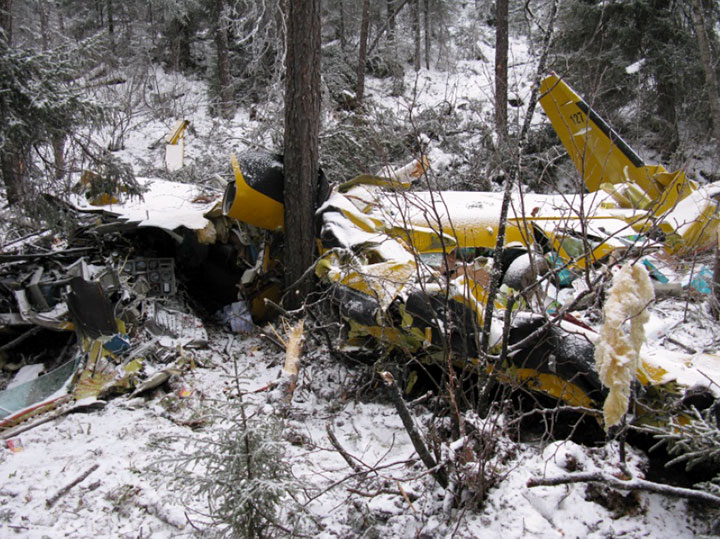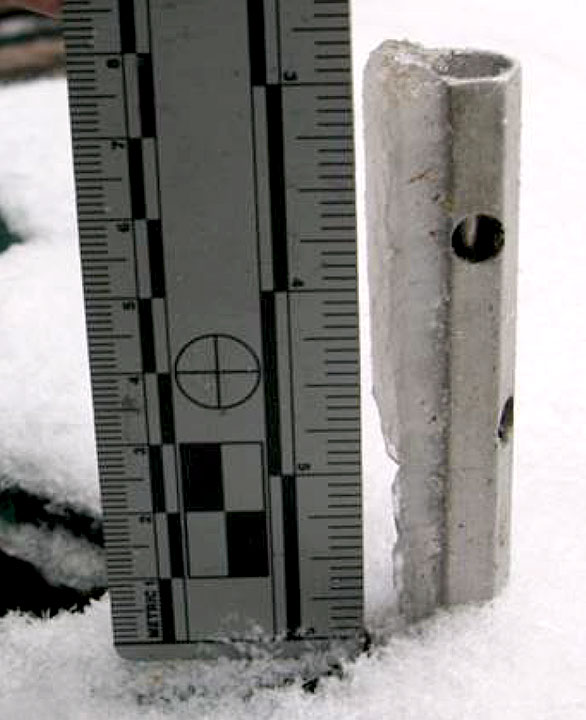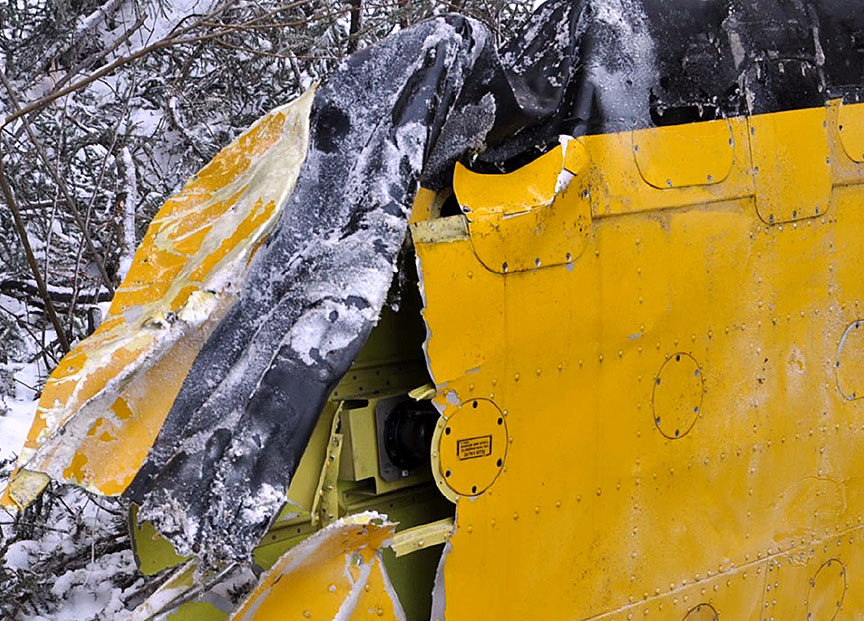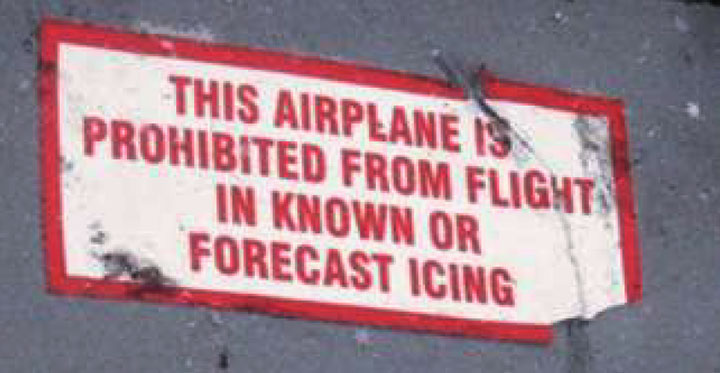How a Cultural Norm Lead to a Fatal C208B Icing Accident
At 09:00 on 11 December 2015 Cessna 208B Caravan C-FKDL, operated by Wasaya Airways, departed Pickle Lake Airport (CYPL) Ontario to Angling Lake / Wapekeka Airport (CKB6) Ontario as flight WSG127. This was a cargo flight under visual flight rules (VFR) operated by a single pilot.
According to the Transportation Safety Board of Canada (TSB) final report:
The aircraft was certified for day and night VFR as well as instrument flight rules (IFR) flight, and it was prohibited from flight in known or forecast icing conditions. The prohibition was prominently placarded in the cockpit in view of the pilot.
The 0800 aerodrome routine meteorological report (METAR) for CYPL was as follows: wind 040°T at 13 knots, visibility 10 sm with light snow, overcast stratocumulus clouds based at 1000 feet AGL, temperature −5 °C, dew point −7 °C, altimeter setting 29.72 inches of mercury (in. Hg).
At 0908, the flight levelled off at about 4600 feet above sea level. At 0909, WSG127 descended and turned about 120° to the right, then collided with the southeast side of Tarp Hill at an elevation of 1460 feet above sea level.
Wreckage of Wasaya Cessna 208B Caravan C-FKDL (Credit: TSB)
End of Recorded Flight Path (Google Earth, with TSB annotations, from ISAT-100 satellite flight tracking system data)
The 406-megahertz emergency locator transmitter activated on impact, but no signal was emitted. Wasaya had equipped its fleet with ISAT-100 satellite flight tracking systems, and Wasaya flight-following staff were aware that WSG127’s status was abnormal within minutes of the accident.
Examination of the airframe wreckage at the crash site revealed accretion of ice about five sixteenths of an inch thick on the outside air temperature probe, antennas and other protruding components.
Ice on the outside air temperature probe (Credit: TSB)
There was residual ice on the de-icing boots on the vertical stabilizer, horizontal stabilizer and right wing indicating that the boots had been operated after in-flight accretion of ice.
Ice on the leading edge of the right wing outboard section (Credit: TSB)
Wasaya Risk Mitigation
The TSB explain that:
In January 2015, Wasaya conducted a risk assessment regarding certifying its Cessna 208B aircraft to operate in known or forecast icing conditions. The assessment identified several hazards, such as lack of pilot experience in such operations, operation of a fleet with mixed configurations, and exceedance of aircraft capabilities as a result of ice accumulation. The risk assessment proposed a number of mitigation strategies and an implementation plan, and concluded that the post-mitigation risk level of moderate was acceptable.
Two mitigation strategies were implemented. The first was new training requirements (the Cessna Cold Weather Operations Course), which the company provided to its Caravan pilots in fall 2015. The second was to make the Cessna 208B pilot’s operating handbook (POH) Supplement S1 available to pilots. Other mitigation strategies had been proposed but had not been fully implemented.
Pilot compliance with Supplement S1 was another strategy that the risk assessment had proposed. However, the investigation determined that some Wasaya Caravan pilots did not always comply with some of the limitations specified in Supplement S1, the Cessna 208B POH, and the Supplemental Type Certificate (STC) aircraft payload extender (APE) III. Multiple flights had been carried out in forecast icing conditions with aircraft that were prohibited from operating in icing, including the 2 flights on the day of this accident. Additionally, the investigation identified 2 instances of Wasaya’s only icing-certified Caravan (C-FHWA) departing into forecast icing conditions with a weight greater than 8550 pounds.
The TSB comment that these non‑compliances were “an indicator of ineffective pilot training and supervision”.
Another mitigation strategy proposed by the risk assessment was amendment of the company’s Cessna 208B standard operating procedures (SOPs) before the company began flights in known or forecast icing conditions. However, as of 11 December 2015, the SOPs had not yet been amended as proposed, and the original edition remained in effect.
A further proposed mitigation strategy was to continue current maintenance practices for de‑icing boot installation and upkeep. However…the company’s current practices had unidentified deficiencies regarding servicing of airframe and propeller boots with ICEX II fluid.
Although the January 2015 risk assessment concluded that the post-mitigation risk level was moderate and acceptable, not all mitigation strategies had been implemented by the time of this accident in December 2015, and the company was exposed to higher risk than it had anticipated.
The unimplemented mitigation strategies were likely the result of missing or ineffective follow-up by Wasaya. On the specified follow-up date in May 2015, the company’s safety management system (SMS) database did not automatically generate follow-up reminders, and it is likely that the absence of a reminder resulted in the follow-up not occurring.
In addition, from 2013 through 2015, Wasaya had experienced difficulty in implementing corrective action plans prepared in response to Transport Canada Civil Aviation (TCCA) findings of regulatory non-compliance; as a result, the company was under enhanced monitoring for a portion of this period.
By December 2015, Wasaya had modified the first of its Caravans, C-FHWA, with additional equipment to certify it for flight in forecast or known icing conditions. The company was collecting information on whether the certified aircraft provided the benefits expected, and the remaining 4 aircraft were still prohibited from such operations.
Thus, Wasaya had not implemented all of the mitigation strategies from its January 2015 risk assessment of Cessna 208B operations in known or forecast icing conditions, and the company remained exposed to some unmitigated hazards that had been identified in the risk assessment.
Review of Wasaya Cessna 208B Operations and Flight Authorisation: “Operation in Icing a Norm”
The investigation examined meteorological information for 09 to 11 December 2015 that would have been readily available to Wasaya’s staff and pilots during the morning preparation for daily operations.
During this period, the graphical area forecasts (GFAs) showed that the northwestern region of Ontario, where Wasaya operated, was expected to periodically experience freezing fog, freezing drizzle, mist, snow, reduced visibility, and low cloud ceilings.
The GFAs indicated that significant icing conditions were expected in the area throughout the period. For each day, the GFAs predicted moderate mixed icing from about 3000 to 5000 feet ASL throughout the area and local spatial coverage of moderate mixed icing from the surface to about 3000 feet ASL due to freezing drizzle.
The investigation also examined Wasaya’s Cessna 208B operations from 09 to 11 December 2015. During this period, the company operated 31 flights with the 3 Caravans based at Pickle Lake Airport (CYPL) and 34 flights with the 2 aircraft based in Red Lake Airport (CYRL). The maximum recorded operating altitudes of VFR flights based from CYRL ranged from 1300 to 2600 feet ASL, whereas those from CYPL ranged from 800 to 8100 feet ASL. Altitudes used for IFR flights ranged from 5500 to 8500 feet ASL. Two of the 65 flights returned to their bases within about 15 minutes after departure.
Placard displayed on C-FKDL and the three other C208B’s that were unequipped for operation in icing conditions (Credit: TSB)
The extensive Cessna 208B operations during this period when icing conditions were forecasted indicates that the associated risk was deemed acceptable to Wasaya, as its risk assessment had concluded. However, the mitigation strategies proposed had not been fully implemented…
Given the forecast icing and the number of flights operating, it was likely that one or more flights would encounter icing conditions possibly exceeding aircraft capabilities.
The TSB thus concluded that a culture of operating in to know icing, despite the incomplete risk mitigations had developed:
The PIC [Pilot in Command] is the final defence in a pilot self-dispatch system and is expected to comply with all rules, procedures, and limitations. In this instance, the pilot released and flew an aircraft that was prohibited from doing so into forecast icing conditions, with catastrophic consequences.
This accident occurred in the context of a company norm of authorizing such flights and Caravan pilots routinely being dispatched into forecast icing conditions…[even though] 4 of Wasaya’s 5 Cessna 208B aircraft were prohibited from operating in these conditions.
Even if C‑FKDL had been equipped and certified for flight in icing conditions, it was being operated at a higher weight and a lower climb speed than was prescribed.
[Furthermore]…the company did not employ any formal risk-management decision support tools (i.e., forms, checklists, etc.) to assist flight operations managers and pilots in identifying and mitigating hazards, nor was it required to do so.
Although the company did have a crew briefing checklist available on its SMS website, there was no requirement to use it. The investigation determined that Wasaya’s Caravan pilots did not use this form, which indicates that its existence was not well known. Even if the form were used, it was better suited to assisting pilots in ensuring pre-flight duties were completed than to identifying hazards or mitigations.
TSB Findings as to Causes and Contributing Factors
- Although the aircraft was prohibited from flying in known or forecast icing conditions, Wasaya Airways Limited Partnership (Wasaya) flight 127 (WSG127) was dispatched into forecast icing conditions.
- The high take-off weight of WSG127 increased the severity of degraded performance when the flight encountered icing conditions.
- The pilot of WSG127 continued the flight in icing conditions for about 6 minutes, resulting in progressively degraded performance.
- WSG127 experienced substantially degraded aircraft performance as a result of ice accumulation, resulting in aerodynamic stall, loss of control, and collision with terrain.
- The Type C pilot self-dispatch procedures and practices in use at Wasaya at the time of the occurrence did not ensure that operational risk was managed to an acceptable level.
- Wasaya had not implemented all of the mitigation strategies from its January 2015 risk assessment of Cessna 208B operations in known or forecast icing conditions, and the company remained exposed to some unmitigated hazards that had been identified in the risk assessment.
- There was a company norm of dispatching Cessna 208B flights into forecast icing conditions, although 4 of Wasaya’s 5 Cessna 208B aircraft were prohibited from operating in these conditions.
TSB Findings as to Risk
- Without effective risk-management processes, aircraft may continue to be dispatched into forecast or known icing conditions that exceed the operating capabilities of the aircraft, increasing the risk of degraded aircraft performance or loss of control.
- If pilots operating under self-dispatch do not have adequate tools to complete an operational risk assessment before releasing a flight, there is an increased likelihood that hazards will not be identified or adequately mitigated.
- If aircraft that are not certified for flight in known or forecast icing conditions are dispatched into, and encounter, such conditions, there is an increased risk of degraded performance or loss of control.
- If aircraft that are certified for flight in known or forecast icing conditions are dispatched into, and encounter, such conditions, at weights exceeding limitations, there is an increased risk of loss of control.
- If flights are continued in known icing conditions in aircraft that are not certified to do so, there is an increased risk of degraded aircraft performance and loss of control.
- If operators exceed aircraft manufacturers’ recommended ICEX II servicing intervals, there is an increased risk of degraded aircraft performance or loss of control resulting from greater accretion of ice on the leading-edge de-icing and propeller blade anti‑icing boots.
- If pilots do not receive the minimum required training, there is an increased risk that they will lack the necessary technical knowledge to operate aircraft safely.
- If pilots are not provided with the information they need to calculate the aircraft’s centre of gravity accurately, they risk departing with their aircraft’s centre of gravity outside the limits, which can lead to loss of control.
- If emergency locator transmitter antennas and cable connections are not robust enough to survive impact forces, potentially life-saving search-and-rescue operations may be impaired by the absence of a usable signal.
Other TSB Findings
- Wasaya’s use of a satellite aircraft flight-following system provided early warning of WSG127’s abnormal status and an accurate last known position for search‑and‑rescue operations.
- The investigation could not determine whether the autopilot had been used by the pilot of WSG127 at any time during the flight.
Safety Actions Taken
Wasaya took the following actions:
- Wasaya discontinued single-pilot operations on the Cessna 208B immediately after the accident. Following a review of operations, the company provided clarification of its single‑pilot procedures to all Caravan pilots. On 11 January 2016, the company resumed single‑pilot operations with modifications to weather limitations for dispatch.
- On 11 January 2016, Wasaya increased the minimum weather requirements for all visual flight rules (VFR) flights conducted under Operations Specification 004, from a ceiling of 300 feet above ground level (AGL) and visibility of 1 statute mile (sm) on a sliding scale
- On 14 February 2016, the company revised its Cessna 208B weight-and-balance (“load control”) form to include a space to record the calculated centre of gravity.
- On the same date, an additional step was incorporated into the approval process for the operational flight plan (OFP), in which the OFP and its component documents were checked for completeness by station operations coordinators or the systems operations control centre (SOCC) flight follower before a flight was dispatched. This step was subsequently revised as follows: when the flight dispatch clearance (FDC) form is completed, it is sent to the SOCC before departure. The FDC is checked for content and for the captain’s signature and is kept by the SOCC for the duration of the flight.
- Following the accident, the company identified that loading crews at CYPL were not providing Cessna 208B pilots with a completed load distribution form. Wasaya reintroduced use of the form in the spring of 2016; however, company follow-up on 16 December 2016 determined that loading crews in CYPL were again not using the load distribution forms for Cessna 208B flights. On 07 March 2017, the Wasaya director of operations (DO) issued a message to address staff confusion regarding when a load distribution form was required to be completed for Caravan flights. The message stated that loadmasters were required to produce the form for any load on a Caravan for which the captain did not supervise the loading, adding that this applied to all Caravan departures from CYPL and Red Lake Airport (CYRL).
- In April 2017, CYPL flight, ground, and operations staff were briefed regarding compliance with this requirement. Follow-up audits by the DO verified that the form was being used for flights for which the pilot did not supervise loading.
- The company increased the time allocated for initial Cessna 208B ground technical training from 2 days to 3 days [thus achieving a regulatory requirement of 20 hours of instruction].
- The company SMS investigation determined that more information was needed [on icing encounters] and proposed developing a means for Cessna 208B pilots to report inadvertent icing encounters. As of 25 April 2017, the SMS had received 2 reports of inadvertent ice encounters: one in which the flight returned to the point of departure, and one in which the flight avoided further icing and continued to destination.
- Wasaya revised its maintenance schedule addendum for the Cessna 208B to incorporate application of ICEX II to propeller anti-icing boots at a maximum interval of 15 hours, and to reduce the maximum interval for application of ICEX II to leading‑edge de‑icing boots to 50 hours.
Our Comment: It is noticeable that none address the weaknesses highlighted by TSB in their risk management process or safety culture.
TSB report that
Transport Canada Civil Aviation (TCCA) conducted a process inspection of Wasaya from 22 December 2015 to 04 January 2016. TCCA advised the company that the process inspection had determined that the company’s Cessna 208 dispatch process was compliant. However, TCCA determined that Wasaya’s ground icing operations program was not effective and did not meet regulatory requirements. On 04 March 2016, Wasaya submitted to TCCA a corrective action plan describing how the company would return to compliance with the regulations. TCCA’s follow-up was completed on 23 December 2016. The Wasaya corrective action plan was accepted, and the process inspection was closed.
TSB also observe:
The presence of flight recording devices can help identify safety deficiencies, which is why the Board previously recommended (Recommendation A13-01) that Transport Canada work with industry to remove obstacles to the implementation of flight data monitoring and the installation of lightweight flight recording systems by commercial operators not currently required to carry them. The Board also issued four other recommendations in 2016 (Recommendations A16-02, A16-03, A16-04 and A16-05) to address deficiencies in ELT design standards which may delay search and rescue operations after an accident. International collaboration is now underway to improve ELT specifications.
Other Safety Resources
If you enjoyed this article you will probably find these Aerossurance case studies of interest:
- Canadian Mining Air Accident (Cessna 208B Caravan) – another case that featured icing
- All Aboard CFIT: Alaskan Sightseeing Fatal Flight – another case with adverse cultural norms about weather
- Execuflight Hawker 700 N237WR Akron Accident: Casual Compliance
- CFIT Gangnam Style – Korean S-76C++ and Decision Making
- HEMS Black Hole Accident: “Organisational, Regulatory and Oversight Deficiencies”
- Culture + Non Compliance + Mechanical Failures = DC3 Accident
- Impromptu Flypast Leads to Disaster, begging more questions on organisational culture.
- DMAIB: Risk Assessment Facilitated Taking Risks
- UPDATE 7 November 2017: Running on Fumes: Fatal Canadian Helicopter Accident
- UPDATE 7 April 2018: Investigators Criticise Cargo Carrier’s Culture & FAA Regulation After Fatal Somatogravic LOC-I. A Shorts 360 N380MQ, operated by SkyWay Enterprises as a Part 135 flight on contract to FedEx crashed in the Caribbean after the crew likely suffered a Somatogravic Illusion raising the flaps on a dark night in 2014. The lack of an FAA SMS regulation for Part 135, the operator’s poor safety culture and implications for the wider industry culture stand out in a thoughtful accident report.
- UPDATE 9 July 2018: In a safety investigation report released last week, the TSB said that the operator of a survey Piper PA-31 Navajo C-FQQB, was unaware that the accident pilots “had frequently flown at very low altitudes” while transiting between survey areas and their base. The Navajo was flying between 40 ft and 100 ft AGL when it struck power cables on 30 April 2017. TSB reiterated a call for flight recorders on smaller aircraft.
- UPDATE 16 January 2019: RCMP AS350B3 Left Uncovered During Snowfall Fatally Loses Power on Take Off
- UPDATE 1 September 2019: King Air 100 Stalls on Take Off After Exposed to 14 Minutes of Snowfall: No De-Icing Applied
- UPDATE 16 September 2019: Fatal Snowy Powerline Inspection Flight
- UPDATE 4 October 2020: Investigators Suggest Cultural Indifference to Checklist Use a Factor in TAROM ATR42 Runway Excursion
- UPDATE 4 August 2022: DC3-TP67 CFIT: Result-Oriented Subculture & SMS Shelfware
Icing was also the topic for a European Aviation Safety Agency (EASA) conference in 2013.
We have also written these other C208 articles:
- Micro FOD: Cessna 208B Grand Caravan Engine Failure & Forced Landing
- NTSB Report on C208B Caravan Ditching, Molokai, Hawaii, 2013
- Flying Control FOD: Screwdriver Found in C208 Controls
- C208B Force Landing After Inadequate Maintenance Fault Finding
- UPDATE 29 November 2018: Iced C208 Loses Airspeed During Circling Approach and Strikes Ground
- UPDATE 31 December 2019: Costa Rican C208B Stalled While Trying To Avoid High Ground
Aerossurance will be presenting at the Royal Aeronautical Society (RAeS) Human Factors in Aircraft Maintenance conference on 2 November 2017 in London. Our topic is: Helicopter Flying Control Maintenance HF Accidents: A Human Centred Design Opportunity
Aerossurance is also pleased to be supporting the annual Chartered Institute of Ergonomics & Human Factors’ (CIEHF) Human Factors in Aviation Safety Conference for the third year running. We will be presenting for the second year running too, this time on the subject of the FSF‘s Maintenance Observation Programme concept.
 This year the conference takes place 13 to 14 November 2017 at the Hilton London Gatwick Airport, UK with the theme: How do we improve human performance in today’s aviation business?
This year the conference takes place 13 to 14 November 2017 at the Hilton London Gatwick Airport, UK with the theme: How do we improve human performance in today’s aviation business?






Recent Comments